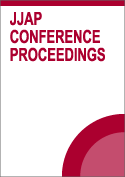Current issue
Displaying 1-7 of 7 articles from this issue
- |<
- <
- 1
- >
- >|
Editors
-
Session ID: E1
Published: 2023
Released on J-STAGE: April 26, 2023
Download PDF (115K)
Foreword
-
Session ID: F1
Published: 2023
Released on J-STAGE: April 26, 2023
Download PDF (134K)
Thermoelectric materials
-
Session ID: 011001
Published: 2023
Released on J-STAGE: April 26, 2023
Download PDF (1114K) -
Session ID: 011002
Published: 2023
Released on J-STAGE: April 26, 2023
Download PDF (905K) -
Session ID: 011003
Published: 2023
Released on J-STAGE: April 26, 2023
Download PDF (772K) -
Session ID: 011004
Published: 2023
Released on J-STAGE: April 26, 2023
Download PDF (1794K)
Optical materials
-
Session ID: 011101
Published: 2023
Released on J-STAGE: April 26, 2023
Download PDF (2541K)
- |<
- <
- 1
- >
- >|
